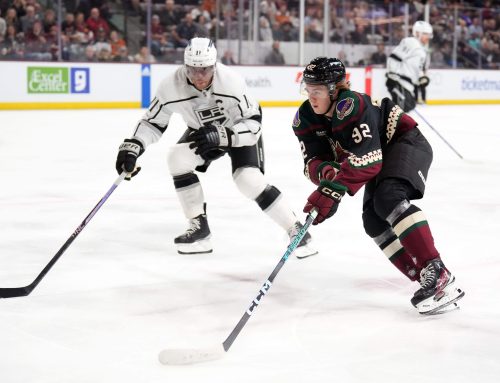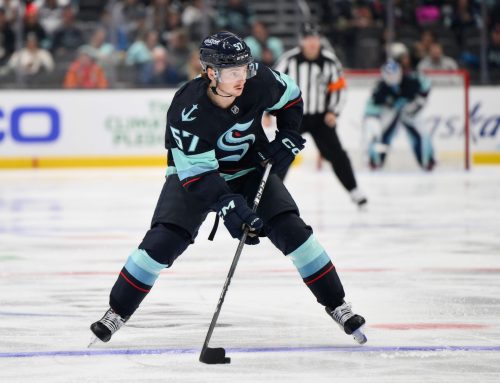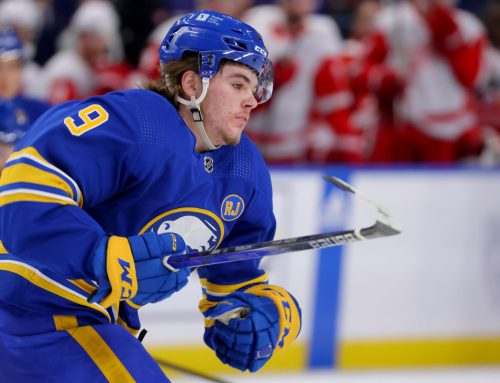The Journey: Avoiding the Ad Populum Fallacy in Fantasy Hockey
Ben Gehrels
2023-05-20
Welcome back to The Journey, where we track the development of prospects as they excel in junior, make the NHL, and push towards stardom.
In theory, fantasy sports are all about numbers. But emotions and psychology often play a significant role in how managers make decisions and build their teams. Some of us love collecting players from our favourite teams. Or players with a certain stat profile who score or hit a lot, for instance. I have fallen many times into the endless siren song of potential: sure, Player A is pretty good right now, but Player B might be better three years from now. What might his ceiling be???
Often we understand our individual biases, preferences, and habits to some extent. But I would argue that we fantasy managers often fall prey to a range of logical fallacies that operate in the background without us fully understanding their impact on our decision-making process. I am going to unite two of my passions by beginning a series this week on how logical fallacies show up in fantasy hockey—what are they, how can you recognize them, and ways that you can exploit them to gain an edge on your competition.
Ad Populum: What is it?
Definition: "An argumentum ad populum (Latin for “appeal to the people”) is a fallacious argument which is based on claiming a truth or affirming something is good because the majority thinks so."
This one is huuuuuuuge in fantasy hockey. You should like Player A more than Player B because most people think so.
I have begun referring to the "fantasy zeitgeist" lately because it's the best way I can think of to refer to the shifting, unstable, but very real collective consciousness that exists in fantasy hockey. Another way would be comparing it to a stock market, but even with a stock market there is the actual value that you see in the numbers and then there is the perceived value in society more generally, which is linked to future projections and other contextual factors and biases.
This zeitgeist is partially generated by industry sources, such as rankings and articles from Dobber, The Athletic, NHL.com, ESPN, The Hockey News, TSN, Elite Prospects, and many others. Most people who play fantasy are constantly perusing rankings and reading articles for little nuggets and gems they can apply to their teams. What the scouts and writers of these outlets say surely has a significant ripple effect in the general understanding of how Player A stacks up next to Player B—even if the industry often sparks heated debate from those who follow and participate in it.
In some cases, the market takes a while to catch up to the actual value of certain players because of their past performance or inconsistency. Dylan Strome (WAS), for instance, or Sam Montembeault (MON). Both these players have been waiver fodder several times in most leagues but now appear to hold decent value heading into 2023-24 even though they are still perceived as worthless in many quarters.
I suspect that for every fan online who thinks Craig Button's 2023 Draft rankings are suspect because he has Jayden Perron at 86th overall, for example, there are ten others taking Button's assessments more or less at face value because of his perceived credibility as an industry insider with TSN. That "more or less" is the key: if you assume Button's assessment of a player is solid strictly because of who he is, that's an appeal to authority, another logical fallacy. He might be right in the end about Perron's NHL projection, but his assessment is not necessarily correct right now just because he said it.
Zooming out further, a player is not necessarily good or bad just because a lot of people think so, whether that's in the league chat, forums, or articles. If you succumb to the pressure of public opinion, you're falling prey to ad populum.
How to Avoid Ad Populum
The thing is, most of us don't have the time to do our own scouting and in-depth research. The average poolie does not have InStat access, which allows you to watch game footage of prospects in action, and it can be expensive to access the wide range of subscription-based services that help provide a fuller picture on player performance. Some of my favourites: Hockey Prospecting, JFresh's Player Cards, All Three Zones, Hockey Viz, Evolving Hockey, and Mitch Brown and Lassi Alanen's Microstats. That is why using industry experts as touchstones is so attractive. They pay all the fees and put the hours in watching these players and talking with NHL executives and scouts; then they write up their assessments and all we have to do is read them.
Still, it takes work to avoid agreeing with the majority simply because it is the majority viewpoint—and with "experts" simply because they have the backing of a brand. Fantasy is all about gaining an edge in value, whether through drafting, trading, or mining the waiver wire, and if you float in the clouds of consensus, it can be difficult to find that edge. I get a hit of dopamine every time I read a few articles and rankings on a player, then dig into their stats and footage myself and end up disagreeing with the majority in some way. It feels risky, like a secret I have discovered. What to do with this newfound power? How much to trust it?
I remember watching Cam Robinson (EP Rinkside) battling to avoid ad populum in the lead-up to the 2020 draft. He had Quinton Byfield (LAK) ranked first overall ahead of the massive favourite, Alexis Lafreniere (NYR), on the basis of his unicorn-like set of skills: he was big, smooth-skating, and had soft hands in tight. The consensus on Lafreniere was so overpowering that Robinson was taking a lot of heat for keeping him at #2. Neither player has really broken out yet at the NHL level, so this is still an ongoing debate. But I appreciated the way Robinson learned from his past mistakes (ie. switching his ranking to align with the majority) and stuck to his guns on Byfield.
To me, that is the key to avoiding the pressure of consensus: form your own assessment of players, however you choose to do that. Personally, I start with expert opinions (rankings, in-depth articles, tweets, scouting reports) to get the big picture—what are a player's general strengths and weaknesses, what do most people think their NHL projection and timeline look like, etc. If the player has seen a decent stretch of NHL action, that gives us a lot more information to work with.
Dobber player profiles provide a ton of information for free; no subscription required. My favourite stats to get a quick, pretty accurate snapshot on a player include: PDO, IPP, xGF/60, Secondary Assist %, PP %, TOI, and rate stats (points, shots, hits, blocks, face-off wins per game). As anyone who follows this column knows, I also adore the Player Usage Charts, which show how much ice time a player has had (bigger bubble = more ice time) and how well they have driven play (blue = good) against what level of competition (higher = harder). If they are still struggling to drive play despite being sheltered, that suggests they are not ready for a bigger role, and vice versa.


So, gathering expert opinions and then drilling into the stats yourself are great ways to ensure you are not being unduly swayed by the majority. Once you have formed your own opinion on a player, another important point is to let go of your ego. Especially if you have found an edge, some information on a player that flies in the face of their general assessment, you need to expect that fellow managers will be critical. No one enjoys getting roasted in the league chat after completing a trade. But really, who cares? You might end up being wrong, but you developed an opinion, made a value assessment, and took a risk. The chirps in the chat are usually just people regurgitating the popular opinion, which you have taken pains to avoid.
The importance of letting go of your ego is especially important in trades where you strategically overpay to get it done. In my experience, most managers will not accept a deal they did not propose themselves unless they feel there is a clear edge in value going back their way. Strategic Overpay involves parting with more assets than is strictly necessary to get a deal done but then replacing those assets for free either off the wire or from your farm—with the new cap space you just opened up, for example, in cap leagues. The general populum does not understand Strategic Overpay deals because they zoom in on the deal itself and try to crown a winner. But if you look around the deal, the scales balance. There is more to it than the pieces in play. It requires letting go of your ego's need to have won the deal. Lose the deal, technically, but get your player.
Thanks for reading! Follow me on Twitter @beegare for more prospect content and fantasy hockey analysis.





 TOR
TOR BOS
BOS DAL
DAL VGK
VGK EDM
EDM L.A
L.A COL
COL FLA
FLA T.B
T.B VAN
VAN WPG
WPG NYR
NYR
